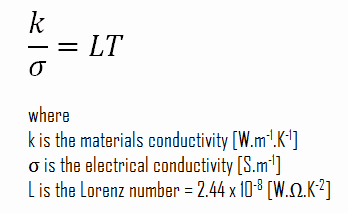At a given temperature, metals’ thermal and electrical conductivities are proportional, but raising the temperature increases the thermal conductivity while decreasing the electrical conductivity. This behavior is quantified in the Wiedemann–Franz law. This law states that the ratio of the electronic contribution of the thermal conductivity (k) to the electrical conductivity (σ) of metal is proportional to the temperature (T).
Qualitatively, this relationship is based upon the fact that heat and electrical transport both involve the free electrons in the metal. The electrical conductivity decreases with particle velocity increases because the collisions divert the electrons from forwarding transport of charge. However, the thermal conductivity increases with the average particle velocity, increasing the forward transport of energy. The Wiedemann-Franz law is generally well obeyed at high temperatures. In the low and intermediate temperature regions, however, the law fails due to the inelastic scattering of the charge carriers.
It must be noted, the general correlation between electrical and thermal conductance does not hold for other materials, due to the increased importance of phonon carriers for heat in non-metals.
